![]()
![]()
![]()
Use LEFT and RIGHT arrow keys to navigate between flashcards;
Use UP and DOWN arrow keys to flip the card;
H to show hint;
A reads text to speech;
203 Cards in this Set
- Front
- Back
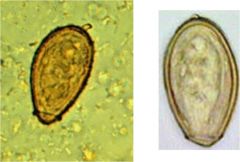
30 um x 16 um
|
Clonorchis sinensis egg
|
|
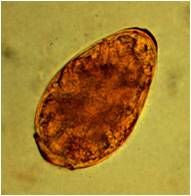
85 um x 55 um
|
Paragoniums westermani egg
-note operculum and terminal shell thickening |
|

0.8-1.6 cm x 0.4-0.8 cm
|
Paragonimus westermani
|
|
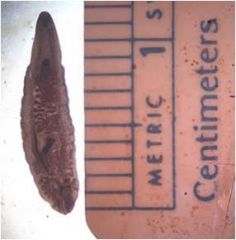
1-2.5cm x 0.3-0.5cm
|
Clonorchis sinensis adult
|
|
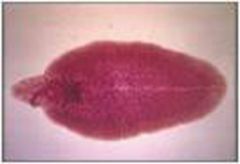
3cm x 1.5cm
|
Fasciola hepatica adult
|
|
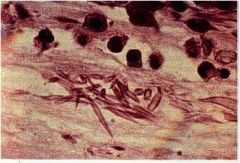
What is this a picture of?
|
Charcot-Leyden crystals - breakdown products from eosinophils
|
|
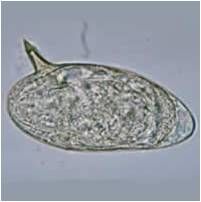
114-180um x 45-73um
|
Scistosoma mansoni eggs
|
|
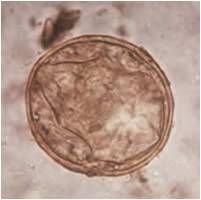
55-85x40-60 um
|
Schistosoma japonicum egg
|
|
|
Define: acetabula (sing: acetabelum)
|
Muscular suckers found on the oral or ventrical surface of flukes
|
|
|
Define: metacercaria
|
Developmental stage of hermaphroditic flukes when the cercaria has shed the tail, secreted a protective wall and encysted in the intermediate host
|
|
|
Define: miracidium
|
Ciliated first-stage free-swimming larva which emerges from the egg and must penetrate the first intermediate host (snails) to continue life cycle
|
|
|
Define: redia
|
Second/third larval stage of trematodes that develops in a sporocyst in the first intermediate host
|
|
|
Define: cercaria
|
Final trematode developmental stage in the snail host
|
|
|
Hermaphroditic flukes are found in ______, and unisexual flukes are found in _______
|
Intestines or organs; blood vessels
|
|
|
What happens to trematodes if the first intermediate host is not available?
|
Trematodes require the first inter. host and will die if it is not available
|
|
|
The metacercaria is found in the first intermediate host (T/F)
|
False; it is found in the 2nd host or on aquatic plants (water chestnuts or bamboo)
|
|
|
Two plants where metacercaria of F. buski or F. hepatica may be found
|
Water chestnuts, bamboo
|
|
|
Geographical distribution of Fasciolopsis buski
|
Asia/southeast asia
|
|
|
The infectious form of Fasciolopsis buski is...
|
Metacercariae attached to aquatic vegetation
|
|
|
The diagnostic form of Fasciolopsis buski or Fasciola hepatica is...
|
Large elliptical, unembryonated, brown eggs with operculum about
|
|
|
Symptoms of Fasciolopsis buski infection
|
Intestinal in nature:
- inflammation, ulceration and hemorrhage - abdominal pain and diarrhea (profuse amts of eggs in stool) - impaired B12 absorption (anemia) - Edema and ascites - Eosinophilia |
|
|
Treatment for Fasciolopsis buski
|
Praziquantel (biltricide) or niclosamide
|
|
|
The characteristic feature that distignuishes heterophyids among other flukes
|
Their small size (<2.5mm)
|
|
|
Infective form of heterophyids
|
Metacercaria in raw/pickled/undercooked freshwater fish
|
|
|
What distinguishes Clonorchis sinenis eggs from that of heterophyids?
|
Clonorchis has more pronounced opercular shoulders and a larger terminal knob
|
|
|
Clinical symptoms of heterophyids
|
Usually asymptomatic unless severe infection; mucoid diarrhea, ab. pain, possible granulomas in heart or brain
|
|
|
What is the natural definitive host of Fasciola hepatica?
|
Sheep
|
|
|
The cephalic cone is a characteristic of which adult trematode?
|
Fasciola hepatica
|
|
|
In which body site would Fasciola hepatica be located?
|
Large biliary passages and gallbladder
|
|
|
What is the infectious form of Fasciola hepatica?
|
Metacercaria from aquatic plants
|
|
|
Symptoms of Fasciola hepatica
|
Jaundice, hepatomegaly, cirrhosis, eosinophilia, 2ndary bacterial infection, biliary obstruction
|
|
|
Treatment for Fasciola hepatica
|
Bithionol
|
|
|
Geographical distribution of Clonorchis
|
China, Japan, Korea, Vietnam
|
|
|
Common name for Clonorchis sinensis
|
Chinese liver fluke
|
|
|
Why must several O/P exams be required to diagnose Clonorchis?
|
It is excreted intermittently
|
|
|
The infectious form of Clonorchis
|
Metacercaria from undercooked freshwater fish
|
|
|
Treatment for Clonorchis
|
Praziquantel
|
|
|
Geographical distribution of lung flukes
|
East and southeast Asia
|
|
|
Humans are accidental hosts for lung flukes. What is the primary host?
|
Cats
|
|
|
"Oriental lung fluke" common name
|
Paragonimus westermani
|
|
|
How is Paragoniums westermani diagonsed?
|
X-ray showing infiltrate in lungs or eggs/"iron filings" from sputum
|
|
|
Iron filings in sputum are indicative of
|
Lung flukes/Paragonums westermani
|
|
|
The infectious form of Paragonimus westermani is
|
Metacercaria from undercooked freshwater crustaceans (crabs/crayfish)
|
|
|
Symptoms of Paragonimus infection
|
Dyspnea, bronchitis, fibrosis; also brain and liver complications can occur
|
|
|
Treatment for Paragonimus
|
Praziquantel
|
|
|
Schistosoma eggs are recovered from
|
Feces (mansoni, japonicum), urine (haematobium)
|
|
|
Differentiate male and female schistosome adult forms
|
Male: 0.6-2.2cm long and cylindrical/curved
Female: 1.2-2.6cm, slender and circular x-section |
|
|
What helps S. mansoni and S. haematobium keep them in place in the blood vessels?
|
Lateral (mansoni) and terminal (haemabotium) pines
|
|
|
What is the infective form of blood flukes?
|
Cercariae from the first intermediate host (snail) penetrate human skin *no secondary intermediate host*
|
|
|
Define: schistosomule
|
The immature schistosome in human tissues after the tail has been lost following penetration of skin
|
|
|
Where do schistosomules mature?
|
Mesenteric and vesicular veins
|
|
|
Geographical distribution of S. mansoni
|
South/central America, Africa, middle east
|
|
|
Diagnostic stage of Schistosoma mansoni
|
Large (140x60um), elongated/ovoid eggs with a large lateral spine
|
|
|
In Schistosomes, the miracidium is (developed/undeveloped)
|
Developed
|
|
|
Compare S. mansoni and S. japonicum eggs
|
S. mansoni: large, elongated, large lat. spine
S. japonicum: medium/small, spherical/oval, minute/absent lateral spine |
|
|
Urinary schistomiasis
|
Caused by Schistosoma haematobium (more needed)
|
|
|
Geographical distribution of Schistosoma haematobium
|
Middle east and mediterranean
|
|
|
Schistosomiasis symptoms
|
Petechiae or edema @ infection site; toxic and allergic symptoms; fever/malaise
Acute stage: liver tenderness, hives(urticaria), ab. pain - diarrhea/dysentery for S. mansoni/japonicum - hematuria/dysuria for S.haematobium |
|
|
Which trematode egg can be found in urine? what does it look like?
|
Schistosoma haematobium; large, elongated with a prominent terminal spine
|
|
|
A brown hematin pigment in phagocytic cells may be seen in
|
Schistosomiasis
|
|
|
Treatment for Schistosomiasis
|
Praziquantel
|
|
|
Describe the life cycle of an intestinal trematode
|
Egg>Miracidium>Sporocyst>Redia>Cercaria>Metacercaria>adult
|
|
|
Which platyhemlinth infects humans via skin penetration and is associated with bladder cancer?
|
Schistosoma haematobium
|
|
|
The egg of which fluke genus IS developed when passed in feces?
|
Schistosoma
|
|
|
What is the preferred specimen for the diagnosis of paragonimiasis?
|
Sputum
|
|
|
Which flukes are acquired by eating contaminated vegetation?
|
Fasciolopsis buski and Fasciola hepaticum
|
|
|
Fish containing metacercariae may transmit which species of fluke?
|
Clonorchis sinensis, Heterophyes heterophyes,
Metagoniums yokogawai |
|
|
Paragonimus westermani is acquired by...
|
Eating infected crustaceans, such as crabs and crayfish
|
|
|
Schistosoma cercariae enter the human body via
|
Penetration of skin or in contaminated drinking water
|
|
|
Bloody urine is a symptom of infection with which species of Digenea
|
Schistosoma haematobium
|
|
|
Differentiate schizogony and sporogony
|
Schizogony: asexual reproduction (multiple nuclear divions before cytoplasmic division)
Sporogony: Sexual reproduction and production of spores/sporozoites |
|
|
The definitive host of Toxoplasma gondii is...
|
Cats
|
|
|
The infective stage of Toxoplasma gondii (for humans) is
|
Oocyst
|
|

|
Toxoplasma gondii tachyzoites
|
|
|
There is a high infection rate in the population for Toxoplasma gondii (T/F)
|
True; up to 75% of the population is infected, but disease is rare (chronic infection)
|
|
|
The two infectious species of Cryptosporidium
|
C. parvum and C. hominis (hominis only infects humans)
|
|
|
The life cycle of Cryptosporidium requires more than one host (T/F)
|
False; cryptosporidium only requires a single host due to autoinfection
|
|
|
The most common symptom of cryptosporidiosis
|
acute and profuse watery diarrhea
|
|
|
Cryptosporidium spores (are/are not) immediately infective
|
Are
|
|
|
Routine chlorination/commercial disinfectant (does/does not) eliminate Cryptosporidium oocysts
|
Does not; requires full strength bleach or 5-10% ammonia
|
|
|
Infective stage of Sarcocystis
|
Sarcocysts in infected meat (via ingestion)
|
|
|
Sarcocysts release _____, which go on to undergo ______ to produce more infective oocysts
|
Bradyzoites; gametogeny
|
|
|
The infective stage of Plasmodium spp.
|
Sporozoites from the saliva of infected mosquitos
|
|
|
Mosquitos become infected with Plasmodium after they...
|
Consume blood containing Plasomdium gametocytes
|
|
|
Geographical distribution of Plasodium
|
Primarily subsaharan Africa; less: SE Asia and S America
|
|
|
Symptoms of malaria:
- time to presentation - initial symptoms - severe symptoms |
Time to pres: 7-10 days
Initial: fever, headache, chills, vomiting (mild to severe) Severe: severe anemia, resp. distress, multi-organ dysfunction, death |
|
|
Following innoculation with Plasmodium sporozoites, the organism travels to the _____ to become _______
|
Liver; cryptozoites
|
|
|
Cryptozoites produce many ______ via ______ reproduction
|
Cryptozoic merozoites; asexual
|
|
|
The exoerythrocytic phase of Plasmodium development consists of:
|
Sporozoites travelling to the liver, becoming cryptozoites, and reproducing asexually to produce many merozoites which then are released into circulation
|
|
|
Plasmodium species with a 3-day fever cycle
|
P. vivax, P. falciparum, P. ovale
|
|
|
Plasmodium species with a 4-day fever cycle
|
P. malariae
|
|
|
Describe red cell preferences (more/less mature) of Plasmodium spp.
- P. vivax - P. falciparum - P. ovale - P. malariae |
vivax: less mature (Schuffer's granules)
malariae/ovale: more mature falciparum: no preference (hence falciparum is the worst) |
|
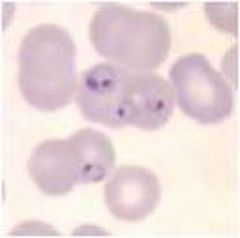
genus? stage?
|
Plasmodium trophozoites [P. falciparum - double signet troph]
|
|
|
Double signets in smaller trophozoites is characteristic of which Plasmodium sp?
|
P. falciparum
|
|
|
Schuffner's granules are seen in which Plasmodium spp?
|
P vivax and P. ovale
|
|
|
Dormancy in the liver is seen in which Plasmodium spp?
|
P vivax and P. ovale
|
|
|
Define: schizont
|
An RBC containing 12-24 merozoites
|
|
|
As the _______ matures, it becomes larger and distorted
|
trophozoite
|
|
|
The P. malariae trophozoite tends to do what within the RBC?
|
Forms a band during early schizogony
|
|
|
The small ring trophozoite and banana shaped gametocyte is most commonly seen in which Plasmodium sp?
|
P. falciparum; mature trophozoites are usually not seen
|
|
|
How is the Accole form of P. falciparum distinguished?
|
The trophozoite is found at the very perimeter of the RBC
|
|
|
Which stain is useful for staining thick smears for Plasmodium diagnosis?
|
Giemsa staining
|
|
|
# of merozoites in the schizont for
- P. vivax - P. ovale - P. falciparum - P. malariae |
- P. vivax: 12-24
- P. ovale: 6-12 - P. malariae: 6-12 - P. falciparum: merozoites not usually seen |
|
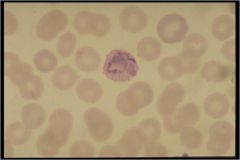
Note Schuffner's dots
|
Plasmodium vivax trophozoite
|
|
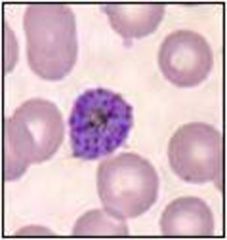
|
P. vivax schizont (note 12+ merozoites)
|
|
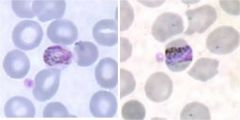
|
P. malariae troph (note the band)
|
|
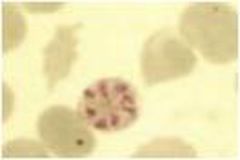
|
P. malariae schizont
note <12 merozoites like P. ovale, and spherical unlike P. ovale |
|
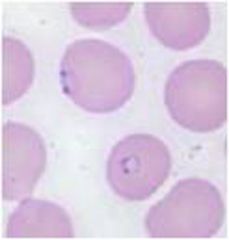
|
P. falciparum trophozoite
- note double signet and small size of troph |
|
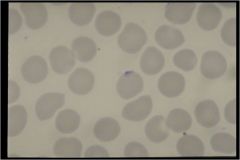
|
Accole form of P. falciparum (troph on perimeter)
|
|
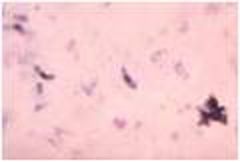
|
P. falciparum gametocytes
|
|

|
P. ovale trophozoite (note oval shape)
|
|
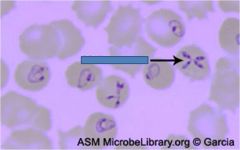
|
Babesia trophozoites (arrow pointing to characteristic "Maltese cross")
|
|
|
Quartan malaria nephropathy is caused by
|
P. malariae
|
|
|
Blackwater fever is caused by
|
P. falciparum
|
|
|
Relapses and superinfections are caused by
|
P. vivax and P. ovale due to latency/sequestration in liver
|
|
|
Treatment for malaria
|
Chloroquinine or other quinines depending on species [multidrug treatment is best]
|
|
|
Specimen requirements for detection of malaria
|
- EDTA or fresh whole blood
- Thin and thick smear - Wright's or Giemsa stained |
|
|
The "ParaSight" test looks for:
|
presence of P. falciparum-specific histidine rich protein via immunochromatographic strip
|
|
|
Vector and geographic distribution of Babesia
|
Ticks;Northeast/coastal US (martha's vinyard)
|
|
|
Babesia trophozoites are similar to trophozoites of which other organism?
|
P. falciparum
|
|
|
Malaria can be acquired via which transmission path other than by being bitten by infected mosquitos?
|
-Transfusion/organ transplant
-congenitally -sharing needles |
|
|
Hemoflagellates are dimorphic, meaning:
|
Morphology differs between vertebrate and invertebrate host
|
|
|
Define: amastigote
|
Small, ovoid, nonflagellated form found in macrophages containing the nucleus and kinetoplast [Trypanosomes]
|
|
|
Define: promastigote
|
Elongated body with a central nucleus and a flagellum [Trypanosomes]
|
|
|
Define: epimastigote
|
Elongated body with undulating membrane and flagellum [Trypanosomes]
|
|
|
Define: Trypomastigote
|
Mature form of a Trypanosome found in peripheral blood; flagellated, undulating membrane and with refractile granules and organelles [Trypanosomes]
|
|
|
The tsetse (Glossina) fly transmits which parasite?
|
Trypanosoma brucei gambiense/rhodesiense
|
|
|
West African sleeping sickness is caused by
|
Trypanosoma brucei gambiense
|
|
|
East African sleeping sickness is caused by
|
Trypanosoma brucei rhodesiense
|
|
|
Initial symptom of T. brucei gambiense is ____
|
asymptomatic or trypanosomal chancre
|
|
|
More severe symptoms of T. brucei gambiense infection
|
Invasion of lymph nodes/enlargement, fever, anorexia, weakness, nausea, vomitting, night sweats
|
|
|
Winterbottom's sign
|
Lymph node enlargement in the posterior cervical region associated with T. brucei gambiense
|
|
|
Kerandel's sign
|
Pressure on palms of hands is followed by severe pain after pressure is removed - T. brucei gambiense
|
|
|
Diagnosis of T. brucei gambiense is achieved by:
|
Demonstration of trypomastigotes in peripheral blood smear or in lymph/CSF
|
|
|
IgM levels remain very high in T. brucei infections due to:
|
Variable surface glycoproteins due to constant gene rearrangement every 1-2 weeks
|
|
|
Which is the more acutely virulent sub-species of T. brucei?
|
T. brucei rhodesiense
|
|
|
Which symptom is usually found in T. brucei gambiense but not in T. brucei rhodesiense?
|
lymphadenopathy
|
|
|
Amastigote forms of hemoflagellates are seen in TISSUE in which organisms?
|
Leishmania spp and Trypanosoma cruzi
|
|
|
Disease caused by T. cruzi
|
Chagas' disease (American trypanosomiasis)
|
|
|
Vector for T. cruzi
|
Reduviid/Triatomid bug
|
|
|
Trypanosoma cruzi infection is acquired when...
|
Epimastigotes enter bloodstream when:
- Triatomid bug feces enters small wound (ie. scratching) - blood transfusion - lab culture - congenital infection |
|
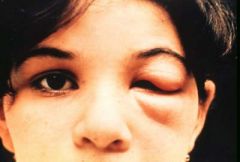
|
Chagoma caused by T. cruzi (periorbital swelling)
|
|
|
small, slender "C-" shaped trypomastigotes are associated with which species?
|
Trypanosoma cruzi
|
|
|
T. brucei trypomastigotes are much ____ than T. cruzi
|
Larger (30+ um compared to 20um for T. cruzi)
|
|
|
Romana's sign
|
Swelling that begins above and below the eye socket and spreads down the neck
|
|
|
Symptoms of chagas disease
|
- fever, malaise, chills, high fever, exhaustion
- symptoms appear ~7-10 days following infection - pinhead size red spots on chest and abdomen - Acute stage: either death or recovery within weeks -Chronic stage: variable periods of remission with occasional fever |
|
|
Most severe symptom in children with T. cruzi infection
|
Meningoencephalitis/CNS involvement with rapid fatality
|
|
|
What are effective host defenses against T. cruzi infection?
|
- Depletion of host's iron stops growth
- Host immunity via IgG and complement |
|
|
When is IFA/EIA testing necessary for diagnosing T. cruzi
|
During the chronic stage of infection
|
|
|
Leishmania is carried by which vector?
|
Sandfly (Lutzomyia/Phlebotomus)
|
|
|
How does protozoa achieve motility?
|
Pseudopodia (amoeboid movement), flagella or cilia
|
|
|
Amebic dysentery and amebiasis is attributed mainly to which pathogenic species?
|
Entamoeba histolytica
|
|
|
Which body sites does E. histolytica invade?
|
Primarily intestinal wall, but also lungs, brain, liver and skin
|
|
|
E. histolytica (can/can not) be sexually transmitted
|
can
|
|
|
A nucleus with a central karyosome and intracellular/engulfed RBC's are characteristic of which protozoa?
|
Entamoeba histolytica
|
|
|
An Entamoeba histolytica cyst can have up to __ nuclei
|
4 (1, 2 or 4)
|
|
|
What is the infective stage of Entamoeba histolyticum?
|
Cyst
|
|
|
What is the diagnostic stage of Entamoeba histolyticum?
|
Cysts or trophs in feces
|
|
|
Why is E. dispar significant?
|
Very similar in appearance to E. histolyticum but is nonpathogenic; E. histo will contain ingested RBC's
|
|
|
E. hartmanni differs from E. histolyticum how?
|
E. hartmanni uch smaller than E. histolyticum, especially the trophs.
|
|
|
How is Entamoeba coli different from E. histolytica?
|
- E. coli has a large, eccentric karyosome
- Ingests bacteria but not RBC's - cyst contains up to 8 nuclei |
|
|
How is E. polecki different from E. histolytica?
|
E. polecki contains up to 2 nuclei and pointed chromatoid bodies, but is otherwise very similar
|
|
|
How is E. gingivalis different from E. histolytica?
|
- no cyst stage
- able to ingest WBC's - found in sputum |
|
|
Iodamoeba butschlii characteristics
|
- single compact nucleus
- large glycogen vacuole that stains brown with iodine |
|
|
How is Endolimax nana different from E. histolytica?
|
- very small
- large irregular karyosome - no peripheral chromatin |
|
|
Which intestinal amoeba is a strict anaerobe?
|
Blastocystis hominis
|
|
|
A large central vacuole with nuclei located along the periphery is characterstic of which intestinal amoeba?
|
Blastocystis hominis
|
|
|
What will water do to Blastocystis?
|
destroy it, causing a possible false negative
|
|
|
Granulomatous amoebic encephalitis is caused by which protozoa?
|
Acanthamoebia spp.
|
|
|
What is a common route of infection with Acanthamoebia?
|
Contact with broken skin or mucous membrane, especially the eyes.
|
|
|
Which species of protozoa is characterized by:
10-25 um wide - round outer membrane, wrinkled inner membrane - single nucleus - trophs rare |
Acanthamoebia
|
|
|
What is the largest protozoan parasite of humans?
|
Balantidium coli (>40 um trophs)
|
|
|
Which animal is a reservoir for Balantidium coli?
|
Pigs
|
|
|
Which structure is very characterstic of Balantidium coli?
|
A kidney-shaped macronucleus
|
|
|
Which condition is caused by Naegleria fowleri?
|
Primary amebic meningoencephalitis (PAM)
|
|
|
How does Naegleria fowleri enter the host?
|
Contaminated water gets into the nose; enters through olfactory lobes
|
|
|
If untreated, how rapidly will death occur with N. floweri infection?
|
3-6 days
|
|
|
Most common intestinal protozoa in the US
|
Giardia lamblia
|
|
|
Route of transmission of G. lamblia
|
Oral fecal route, food contamination
|
|
|
Giardia lamblia is an invasive species (T/F)
|
False; G. lamblia does not invade, but may cause malabsorption in the intestine, which is symptomatic
|
|
|
Visual characteristics:
- 10-20um x 5-15um - bilateral symmetry - central axoneme - 2-4 nuclei (1-2 on each side) - troph has flagellae |
Giardia lamblia
|
|
|
What amoebic parasite is associated with Enterobius vermicularis (pinworm)?
|
Dientamoeba fragilis
|
|
|
What nonpathogenic species is similar to Giardia? How is it different?
|
Chilomastix mesnili; C. mesnili has a spiral groove known as a "shepherd's crook"
|
|
|
Trichomonas vaginalis moves via:
|
4 anterior flagellae and an undulating membrane
|
|
|
Trichomonas vaginalis forms cysts (T/F)
|
False; T. vaginalis exists only as a trophozoite
|
|
|
Trichomoniasis symptoms
|
- frothy, yellow, foul-smelling vaginal discharge
- burning on urination - urethrtitis - treatment: metranidazole |
|
|
How is Trichomonas hominis different from pathogenic T. vaginalis?
|
Has trailing flagella and undulating membrane along entire length of body
|
|

|
Leishmania or T. cruzi amastigotes (depending on body site)
|
|
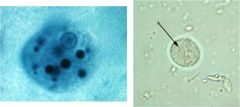
Genus/sepcies/stage
What's the arrow pointing to? |
Entamoeba histolyticum
Arrow: chromatoid body |
|
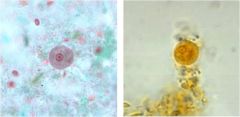
Left: <10 um
Right: <12 um |
Entamoeba hartmanni
|
|
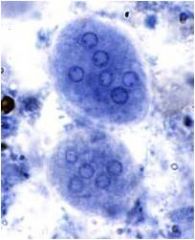
|
Entamoeba coli (note >4 nuclei with eccentric karyosomes)
|
|
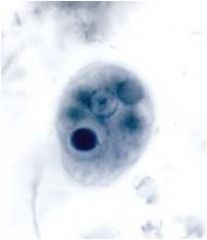
|
Entamoeba gingivalis troph (note consumed WBC)
|
|
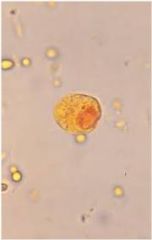
(Iodine stain)
|
Iodamoeba butschlii
|
|
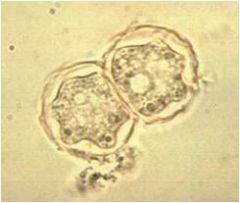
|
Acanthamoebia spp cyst
|
|
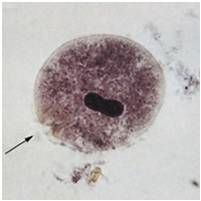
>40 um
|
Balantidium coli (kidney shaped nucleus the giveaway)
|
|

|
Giardia lamblia troph
|
|
|
Of Leishmania tropica causes an acute infection (T/F)
|
False; L. tropica causes a year-long chronic infection
|
|
|
This Leishmania species causes an acute infection lasting 3-6 months; lesions occur primarily on the lower limbs with ulceration
|
Leishmania major
|
|
|
Leishmania mexicana and Leishmania braziliensis cause [disease] in [location] and [location], respectively
|
cutaneous leishmaniasis;
Mexicanis: Texas to Brazil Braziliensis: Peruvial andes |
|
|
Visceral leischmaniasis
|
Caused by Leischmania donovani
- long incubation period - Spiking fever, chills, sweating, diarrhea, weight loss - Splenomegaly and hepatomegaly from RES infection - Untreated: death within 2 yrs |
|
|
Infective form/stage of Leischmania
|
promastigote
|
|
|
Espundia
|
AKA mucocutaneous leishmaniasis
Ulcers on the oral or nasal mucosa; caused by L. braziliensis, L. tropica, L. major |
|
|
Phlebotomus sandflies carry which Leishmania species?
|
L. donovani
|

